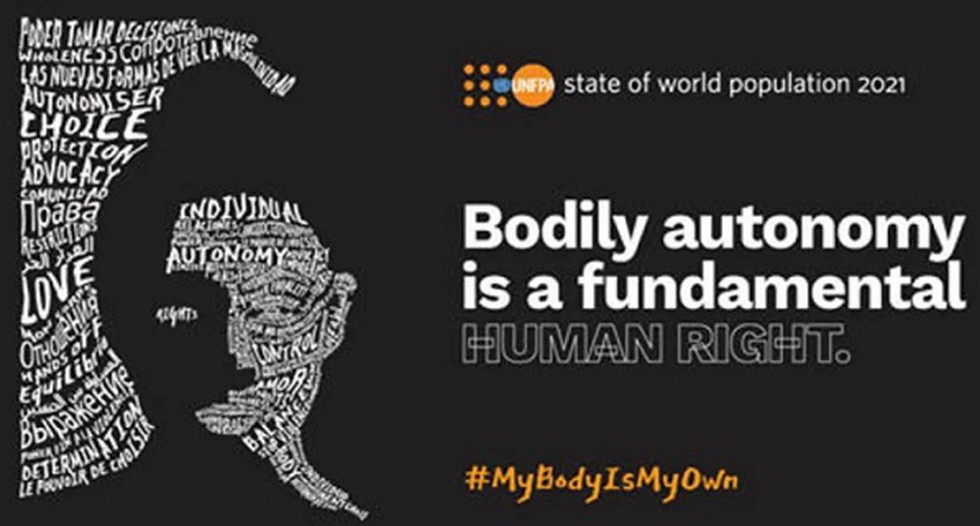
World Population Report 2021: UNFPA
Why in News?
Violation of Bodily Autonomy:
About:
The principle of bodily integrity sums up the right of each human being, including children, to autonomy and self-determination over their own body. It considers an unconsented physical intrusion as a human rights violation.
While the principle has traditionally been raised in connection with practices such as torture, inhumane treatment and forced disappearance, bodily integrity has the potential to apply to wide range of human rights violations, which also affect children’s civil rights.
Under its ambit also fall people with disabilities stripped of their rights to self-determination, to be free from violence and to enjoy a safe and satisfying sexual life.
Some Examples:
1. Child marriage.
2. Female genital mutilation.
3. Lack of contraceptive choices leading to unplanned pregnancy.
4. Unwanted sex exchanged for a home and food.
5. When people with diverse sexual orientations and gender identities cannot walk down a street without fearing assault or humiliation.
Global Scenario:
Right to Make Decisions Regarding Own Body:
Nearly half the women from 57 developing countries do not have the right to make decisions regarding their bodies, including using contraception, seeking healthcare or even on their sexuality.
Only 75% of countries legally ensure full and equal access to contraception.
Effect of Covid:
Recently, the United Nations Population Fund’s (UNFPA) flagship State of World Population Report 2021 titled ‘My Body is My Own’ was launched.
This is the first time a United Nations report has focused on bodily autonomy.
Women around the world are denied the fundamental right of bodily autonomy with the Covid-19 pandemic further exacerbating this situation.
Indian Scenario:
In India, according to National Family Health Survey (NFHS)-4 (2015-2016):
Healthcare:
12% of currently married women (15-49 years of age) independently make decisions about their own healthcare.
63% decide in consultation with their spouse.
For 23% it is the spouse that mainly takes decisions about healthcare.
Contraceptives:
8% of currently married women (15-49 years) take decisions on the use of contraception independently.
83% decide jointly with their spouse. Information provided to women about use of contraception is also limited.
47% of women using a contraceptive were informed about the side effects of the method.
54% women were provided information about other contraceptives.
Some Women Related Data from NFHS-5:
Contraception:
Overall Contraceptive Prevalence Rate (CPR) has increased substantially in most States/UTs and it is the highest in HP and WB (74%).
Domestic Violence:
It has generally declined in most of the states and UTs.
However, it has witnessed an increase in five states, namely Sikkim, Maharashtra, Himachal Pradesh, Assam and Karnataka.
Decision making related to health, major household purchases and visiting relatives:
Bihar has reported the maximum increase from 75.2% in NFHS-4 (2015-2016) to 86.5% in NFHS-5 (2019-2020).
Almost 99% of women in Nagaland participate in household decision-making, followed by Mizoram at 98.8%.
On the other hand, Ladakh and Sikkim reported the biggest decrease in women’s participation in decision-making, with a 7-5% drop among married women.
Related Supreme Courts (SC) Judgement:
Justice K S Puttaswamy v Union of India 2017:
The SC held that reproductive rights include a woman’s entitlement to carry a pregnancy to its full term, to give birth, and to subsequently raise children; and that these rights form part of a woman’s right to privacy, dignity, and bodily integrity.
The judgement gave required impetus to resolve the potential constitutional challenges to abortion and surrogacy.
Recently, the Medical Termination of Pregnancy (MTP) (Amendment) Bill, 2020 was passed which seeks to extend the termination of pregnancy period from 20 weeks to 24 weeks, making it easier for women to safely and legally terminate an unwanted pregnancy.
United Nations Population Fund
About:
It is a subsidiary organ of the UN General Assembly and works as a sexual and reproductive health agency.
The UN Economic and Social Council (ECOSOC) establishes its mandate.
Establishment:
It was established as a trust fund in 1967 and began operations in 1969.
In 1987, it was officially renamed the United Nations Population Fund but the original abbreviation, ‘UNFPA’ for the United Nations Fund for Population Activities was retained.
Objective:
UNFPA works directly to tackle Sustainable Development Goals on health (SDG3), education (SDG4) and gender equality (SDG5).
Fund:
UNFPA is not supported by the UN budget, instead, it is entirely supported by voluntary contributions of donor governments, intergovernmental organizations, the private sector, foundations and individuals.
